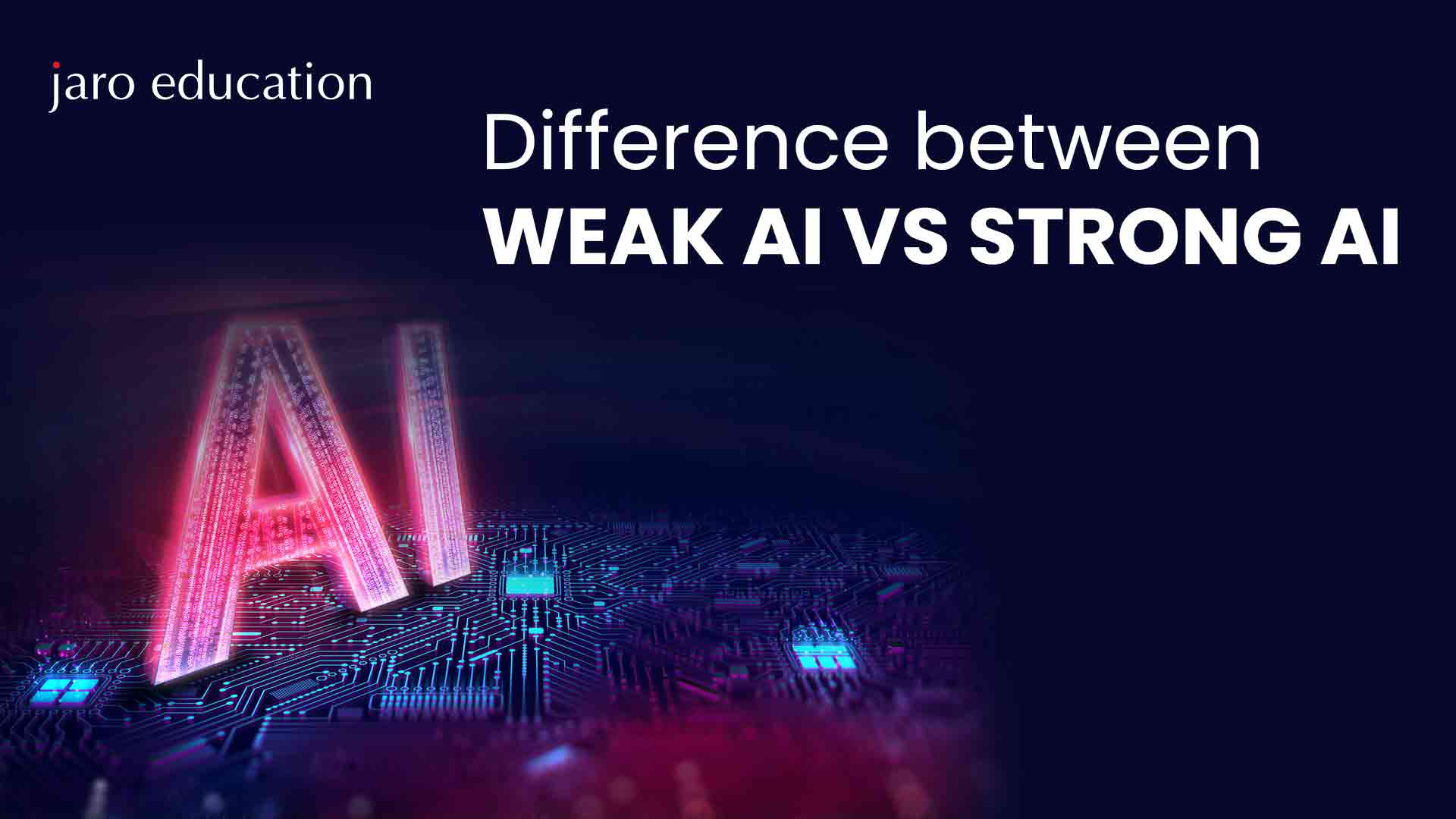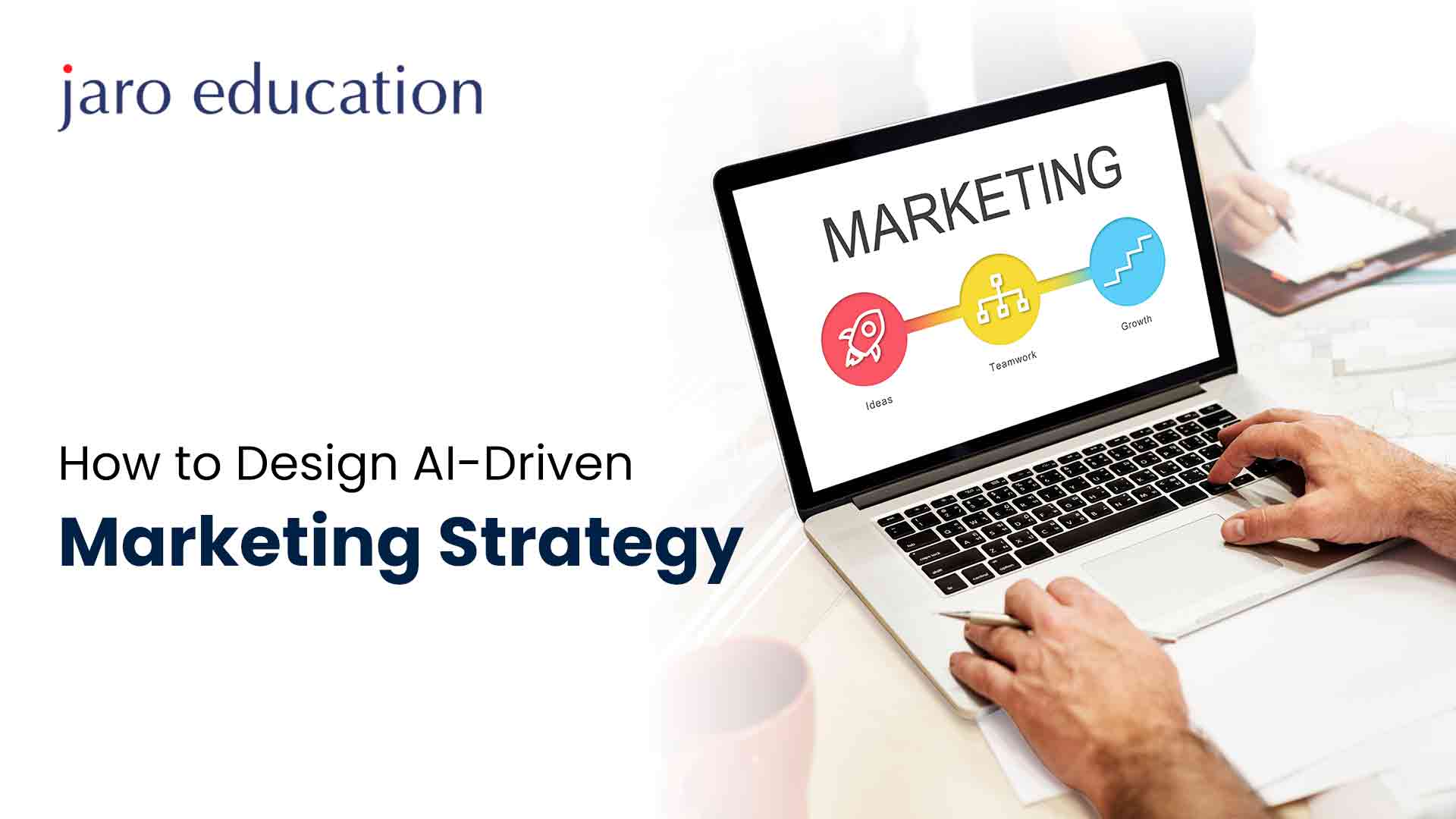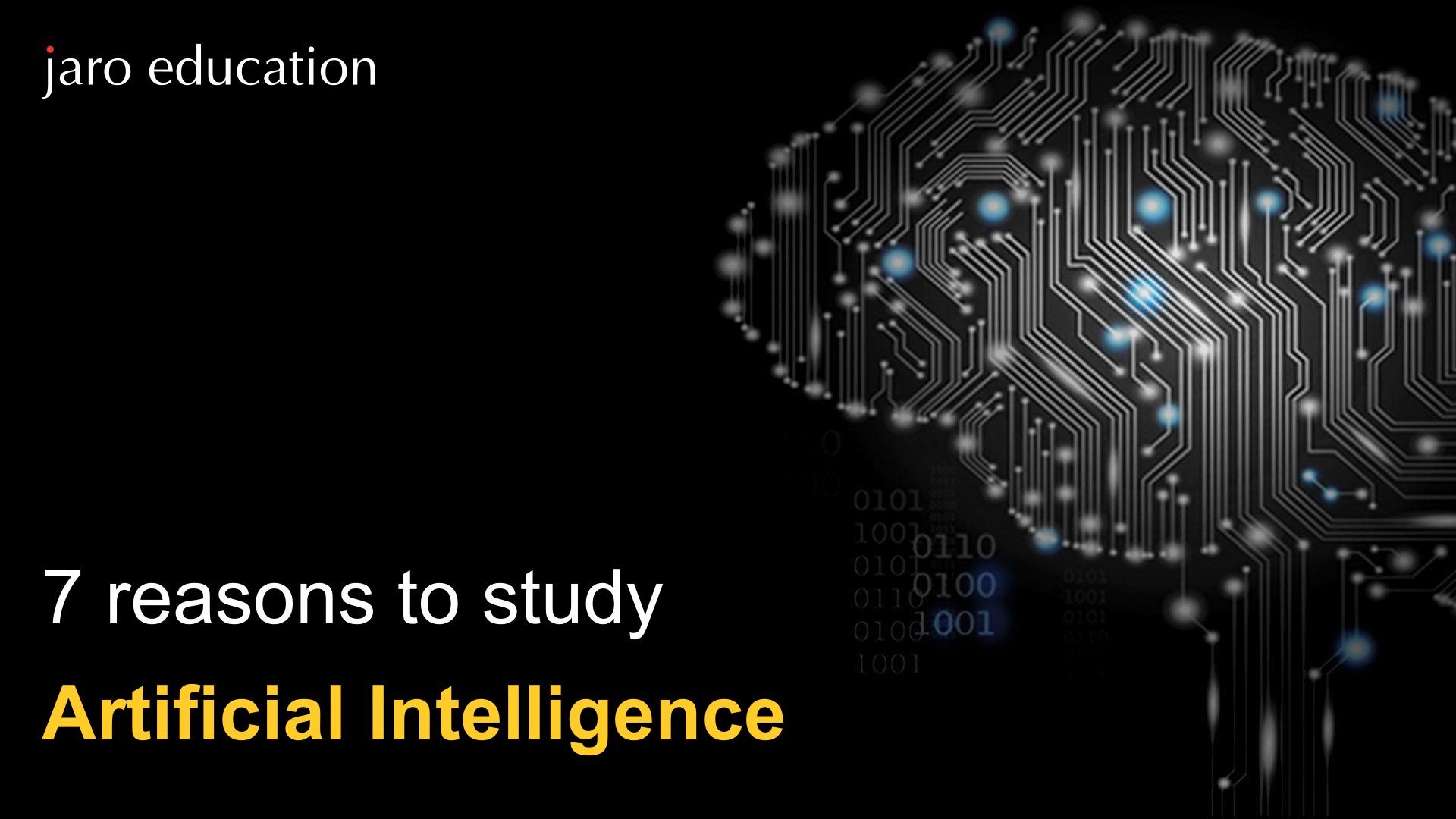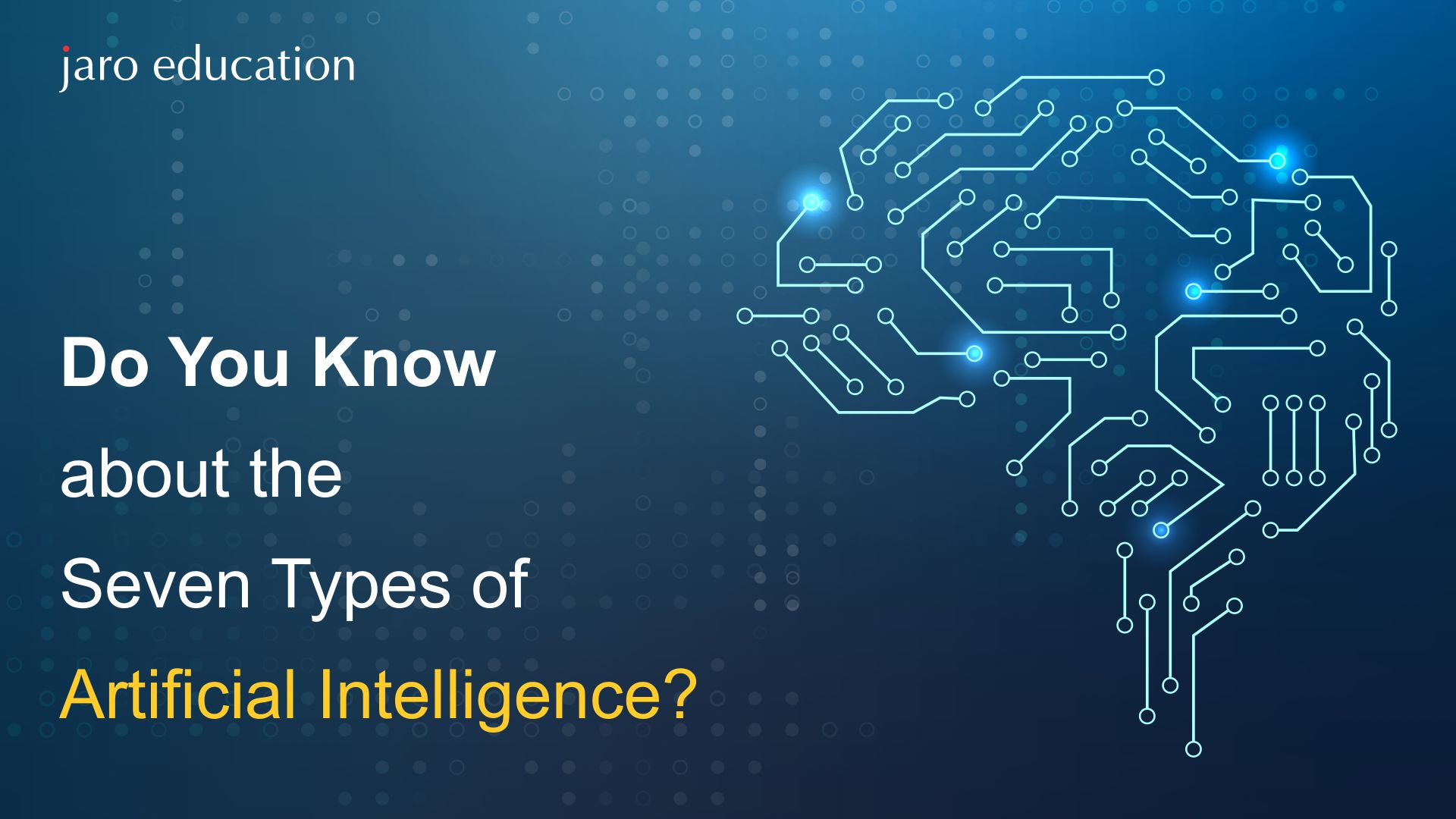
- jaro education
- 27, February 2024
- 2:00 pm
Artificial intelligence (AI) has emerged as a pivotal force in modern technology, and there is no denying that. It is significantly altering various facets of our society and everyday life. From revolutionizing industry practices to enhancing personal convenience, AI’s influence is widespread and continually expanding. The AI market, currently valued at $150.2 billion, is poised for substantial growth, with projections indicating a twentyfold increase by the year 2030 alone.
Central to understanding AI’s diverse applications are the concepts of “weak AI” and “strong AI.” These terms represent two fundamentally different approaches and capabilities within the field of AI. Weak AI, typically designed for specific tasks, is already integrated into various aspects of our lives, driving innovations in sectors like customer service and data analysis. In contrast, Strong AI, which is more theoretical at this stage, represents AI systems that possess generalized human cognitive abilities, allowing them to perform any intellectual task that a human being can.
This distinction sets the stage for a deeper exploration into how these two forms of AI differ not only in their capabilities but also in their impact on future technology and societal change. This article aims to delve into these differences, offering insights into the current state and future potential of AI in our world.
What is Weak AI?
Table of Contents
Weak AI, also known as Narrow Artificial Intelligence, is designed to perform specific tasks or solve particular problems. Unlike Strong AI, it doesn’t possess consciousness, true understanding, or general intelligence akin to human beings. It operates within a limited context and doesn’t possess consciousness or self-awareness. Its functionality is restricted to the parameters of its programming, meaning it operates within a predefined scope and cannot go beyond it.
Examples of Weak AI in Current Technologies
1. Chatbots in Customer Support
Many businesses employ chatbots on their websites to handle routine customer queries, providing instant responses and freeing up human agents for more complex issues.
2. Language Translation Services
Weak AI is utilized in language translation apps and services, allowing users to translate text or speech from one language to another.
3. Spam Filters in Email
Email services often employ weak AI algorithms to detect and filter out spam, ensuring that users receive relevant and legitimate emails.
4. Image and Object Recognition in Smartphones
Smartphone cameras use weak AI for image recognition, enabling features like facial recognition for unlocking devices and identifying objects in photos.
5. Predictive Text and Auto-Correction
Smart keyboards on mobile devices leverage weak AI to predict and suggest words while typing, as well as automatically correct spelling errors.
6. Social Media Content Recommendations
Social Media Platforms like Facebook and Instagram use weak AI algorithms to analyze user behavior and provide personalized content recommendations, such as friend suggestions or posts in the news feed.
7. Navigation Apps
GPS navigation apps utilize weak AI to analyze real-time traffic data, optimize routes, and provide users with accurate and efficient directions.
8. Fraud Detection in Banking
Weak AI is employed in banking systems to detect potentially fraudulent transactions by analyzing patterns and anomalies in user spending behavior.
9. Smart Home Devices
Devices like smart thermostats, lights, and security cameras use weak AI to learn user preferences and adapt their functionality accordingly.
10. Health and Fitness Apps
Weak AI is integrated into health and fitness apps to track and analyze users’ exercise routines, providing insights and personalized recommendations for a healthier lifestyle.
Explore the forefront of technology with Executive Programme in Data Science using Machine Learning & Artificial Intelligence by IIT Delhi. Gain a comprehensive understanding of cutting-edge concepts, including Weak AI, also known as Narrow AI.
Characteristics of Weak AI
Task-Specific Design
Weak AI, characterized by its task-specific design, is meticulously crafted to excel in particular domains such as language translation or image recognition. Unlike broader forms of artificial intelligence, Weak AI is finely tuned to accomplish specific objectives, exhibiting a targeted and efficient approach to problem-solving.
Limited Understanding
Operating within the confines of programmed algorithms, Weak AI demonstrates the ability to interpret data and execute predefined tasks. However, it is important to note that its comprehension is limited to the explicit instructions provided, and it lacks a genuine understanding of the content it processes. In essence, it performs tasks based on predetermined rules without grasping the underlying meaning or context.
No Self-Awareness
One of the defining features of Weak AI is its absence of consciousness and self-awareness. While it can carry out assigned functions effectively, it does so without any form of subjective awareness or understanding. The absence of self-awareness distinguishes Weak AI from more sophisticated forms of artificial intelligence that exhibit a level of consciousness akin to human cognition.
Adaptability and Learning
Weak AI possesses a degree of adaptability and learning within the specific scope of its assigned task. Through machine learning techniques, it can refine its performance over time by analyzing patterns and optimizing outcomes. However, it’s essential to recognize that this learning is confined to the task for which it is designed and does not extend to generalizing knowledge or skills across unrelated domains. The adaptability of Weak AI is localized, focusing on enhancing performance within its predefined parameters.
What is Strong AI?
Strong AI, or Artificial General Intelligence (AGI), represents the more advanced and theoretical end of the AI spectrum. It is a theoretical form of AI that mirrors human intelligence. It’s capable of understanding, learning, and applying knowledge across various domains. Strong AI is self-aware, possesses consciousness, and can engage in creative problem-solving. Unlike Weak AI, Strong AI is conceptualized to have the ability to understand, learn, and apply its intelligence to a wide range of problems, much like a human being. This form of AI is not just programmed for specific tasks; instead, it possesses general intelligence and problem-solving skills that are applicable in any context.
Potential of Strong AI
The advent of Strong AI holds immense promise, representing a paradigm shift with far-reaching consequences across various domains. The potential applications are vast, encompassing:
1. Capacity to Solve Complex Problems
Strong AI has the capacity to excel in intricate problem-solving tasks, ranging from scientific research to optimizing global logistics. Its ability to process vast datasets and draw insightful conclusions could accelerate progress in diverse fields.
2. Understanding Human Emotions
A key potential lies in Strong AI’s capability to comprehend human emotions and contextual nuances. This breakthrough could revolutionize industries such as education, mental health, and interpersonal communication by fostering more empathetic and personalized interactions.
3. Medical Discoveries
Strong AI’s analytical prowess could significantly contribute to medical research and diagnostics. It may unravel complex patterns in health data, leading to breakthroughs in disease detection, treatment optimization, and drug discovery.
4. Enhanced Learning and Education
The implementation of Strong AI in education could revolutionize the learning experience. Personalized learning paths, adaptive tutoring systems, and tailored curriculum recommendations could cater to individual student needs, fostering more effective and inclusive education.
5. Learning and Reasoning
AI has the ability to learn from new information and reason through complex scenarios. It can acquire knowledge from various domains, draw connections between different concepts, and apply its understanding to novel situations.
Ethical and Technical Challenges of AI
1. Employment Disruption
The widespread adoption of Strong AI raises concerns about potential job displacement as automation takes over routine and complex tasks. Preparing the workforce for this transition and mitigating socioeconomic impacts pose significant challenges.
2. Privacy Concerns
The integration of Strong AI into various aspects of life raises questions about individual privacy. Striking a balance between harnessing AI’s capabilities and safeguarding personal information is crucial to prevent unauthorized access and misuse.
3. Societal Impact
The transformation brought about by Strong AI may disrupt established societal structures. Addressing issues related to inequality, accessibility, and ensuring that AI benefits society as a whole are imperative considerations.
4. Technical Complexity
Achieving Strong AI requires a deep understanding of human cognition and consciousness, a domain where our current knowledge is limited. The technical challenges include replicating human-like reasoning, self-awareness, and adaptability in machines.
Weak AI vs Strong AI - A Comparative Analysis
| Aspect | Weak AI | Strong AI |
|---|---|---|
| Definition | AI designed for specific tasks with a limited scope. | AI with generalized intelligence, similar to human cognition. |
| Capabilities | Excels in specialized tasks such as language processing and image recognition. | Theoretically capable of any intellectual task that a human can do. |
| Learning | Learns from specific data sets; improvements are confined to its programmed domain. | Capable of learning autonomously and applying knowledge across various domains. |
| Consciousness | Lacks self-awareness, operates based on programmed algorithms. | Potentially could possess self-awareness and understanding. |
| Adaptability | Limited adaptability, cannot go beyond its specific function. | Highly adaptable, can handle unforeseen situations and tasks. |
| Examples | Siri, Alexa, recommendation algorithms, chatbots. | Hypothetical strong AI might engage in complex problem-solving, exhibit creativity, demonstrate emotional intelligence. |
Weak AI And Strong AI’sImpact on Industries
Both forms of AI could vastly transform industries. Weak AI streamlines and improves efficiency Strong AI, on the other hand, could lead to groundbreaking innovations.
Weak AI: Streamlining Efficiency and Enhancing Specific Tasks
1. Healthcare
Weak AI applications contribute to streamlined healthcare operations. They excel in tasks like data analysis, aiding in diagnostics, personalized treatment plans, and drug discovery. Virtual personal assistants help manage patient data efficiently, ensuring better healthcare delivery.
Example: IBM Watson Health utilizes Weak AI to analyze vast amounts of medical literature, patient records, and clinical trial data. It aids doctors in diagnosing illnesses, recommending personalized treatment plans, and staying updated on the latest medical research.
2. Marketing
In marketing, Weak AI plays a pivotal role in customer segmentation, enhancing targeted advertising efforts. Recommendation systems powered by Weak AI algorithms analyze user behavior, offering personalized product suggestions and improving overall customer experience.
Example: Weak AI algorithms power recommendation systems in platforms like Netflix and Amazon. By analyzing user preferences and behaviors, these systems suggest movies, shows, or products tailored to individual tastes, enhancing the overall customer experience.
3. Finance
The financial sector benefits from Weak AI through algorithmic trading, fraud detection, and customer service chatbots. These applications optimize processes, ensuring faster and more accurate decision-making in areas such as risk assessment and fraud prevention.
Example: Chatbots in banking, such as Bank of America’s Erica, use Weak AI to provide customers with account information, answer queries, and assist in transactions. This streamlines customer service and offers users a convenient way to manage their finances.
4. Manufacturing
Weak AI finds application in optimizing manufacturing processes, predictive maintenance, and quality control. Automated systems powered by AI enhance production efficiency, minimize downtime, and contribute to overall cost-effectiveness.
Example: Weak AI is integrated into manufacturing processes through predictive maintenance systems. Companies like Siemens use AI to predict equipment failures, enabling proactive maintenance and minimizing downtime in factories.
Strong AI: Pioneering Groundbreaking Innovations
1. Medical Research
The potential impact of Strong AI in healthcare is revolutionary. It could lead to breakthroughs in medical research by autonomously analyzing vast datasets, identifying correlations, and accelerating the discovery of novel treatments and therapies.
Example: Google’s DeepMind is exploring the potential of Strong AI in healthcare. Its algorithms analyze medical images, aiding in the early detection of diseases like diabetic retinopathy, and showcasing the potential of AI to revolutionize diagnostic capabilities.
2. Urban Planning
Strong AI has the capability to manage large-scale systems, transforming urban planning. From optimizing traffic flow and energy consumption to predicting environmental impact, Strong AI can contribute to creating smart cities that are efficient, sustainable, and responsive to evolving needs.
Example: Singapore employs AI in urban planning through its Smart Nation initiative. AI systems analyze data from various sources, optimizing traffic flow, predicting energy consumption, and contributing to sustainable city development.
3. Scientific Exploration
In scientific domains, Strong AI could aid researchers in analyzing complex phenomena, conducting simulations, and formulating hypotheses. This could expedite scientific discoveries across disciplines, from physics to environmental science.
Example: CERN, the European Organization for Nuclear Research, utilizes AI in its experiments. AI algorithms analyze massive datasets generated by particle accelerators, helping physicists identify patterns and anomalies in their quest for understanding fundamental particles.
4. Education
The educational sector could witness profound changes with Strong AI. Personalized learning experiences, intelligent tutoring systems, and adaptive curricula tailored to individual student needs could redefine education, fostering enhanced understanding and knowledge retention.
Example: Carnegie Learning’s AI-driven educational software personalizes learning experiences for students. The system adapts to individual needs, providing targeted exercises and feedback, showcasing the potential of Strong AI in reshaping traditional education.
Having explored the transformative effects of both Weak AI and Strong AI across various industries, professionals aiming to thrive in this dynamic and ever-evolving field are encouraged to stay updated on advancements in data science, machine learning, and artificial intelligence. For that, IIT Delhi presents a unique and exceptional opportunity for professionals. The meticulously curated ‘Executive Programme in Applied Data Science using Machine Learning & Artificial Intelligence‘ is strategically crafted to empower participants with essential skills in AI applications.
The Role of AI in Enhancing Customer Experiences
The deployment of sophisticated chatbot systems has revolutionized customer interactions, offering benefits that extend beyond mere query resolution. Here are few ways AI is enhancing customer experiences and driving growth for businesses.
*sproutsocial.com
Efficiency and Versatility
The best chatbots for websites are distinguished by their ability to efficiently handle diverse customer queries. Whether addressing product inquiries, troubleshooting issues, or providing information, these chatbots exhibit remarkable versatility. Their adaptive nature allows them to learn from each interaction, continuously refining responses for a more personalized customer experience.
Seamless Integration
Integration capabilities are a hallmark of top-tier chatbots. They seamlessly integrate with various service platforms, ensuring a cohesive customer service ecosystem. This integration goes beyond textual interactions, encompassing voice-based queries and even interfacing with other AI-driven tools for a comprehensive customer support approach.
24/7 Availability
A standout feature of AI-powered chatbots is their round-the-clock availability. Unlike traditional customer service models constrained by office hours, chatbots tirelessly engage with customers, providing instant responses regardless of the time zone or business hours. This perpetual accessibility enhances customer satisfaction and fosters a sense of reliability.
Personalized Responses
Learning from each customer interaction, chatbots evolve to deliver increasingly personalized responses. By analyzing user preferences, purchase history, and engagement patterns, these AI systems tailor their interactions, creating a more individualized customer experience. This personalized touch contributes significantly to customer retention and loyalty.
Customer Experience Enhancement
Beyond resolving queries, AI-driven chatbots contribute to an overall enhancement of the customer experience. They facilitate a smoother and more efficient interaction process, reducing wait times and ensuring prompt issue resolution. The automated yet personalized nature of these interactions aligns with modern customer expectations, leading to higher satisfaction levels.
Conclusion
The fundamental distinctions between Weak AI and Strong AI are rooted in their scope, capabilities, and potential impacts. Weak AI, tailored for specific tasks, is already enhancing efficiency and user experience across various sectors. On the other hand, Strong AI, boasting theoretical general intelligence, holds the promise of groundbreaking advancements but also introduces significant ethical and technical challenges.
Standing at the threshold of these AI advancements, the future unfolds with both remarkable opportunities and profound responsibilities. It prompts us to contemplate: how will we influence and be influenced by the AI of tomorrow? This contemplation extends beyond technological progression to encompass the human values and ethics we opt to integrate into our AI-driven future.









